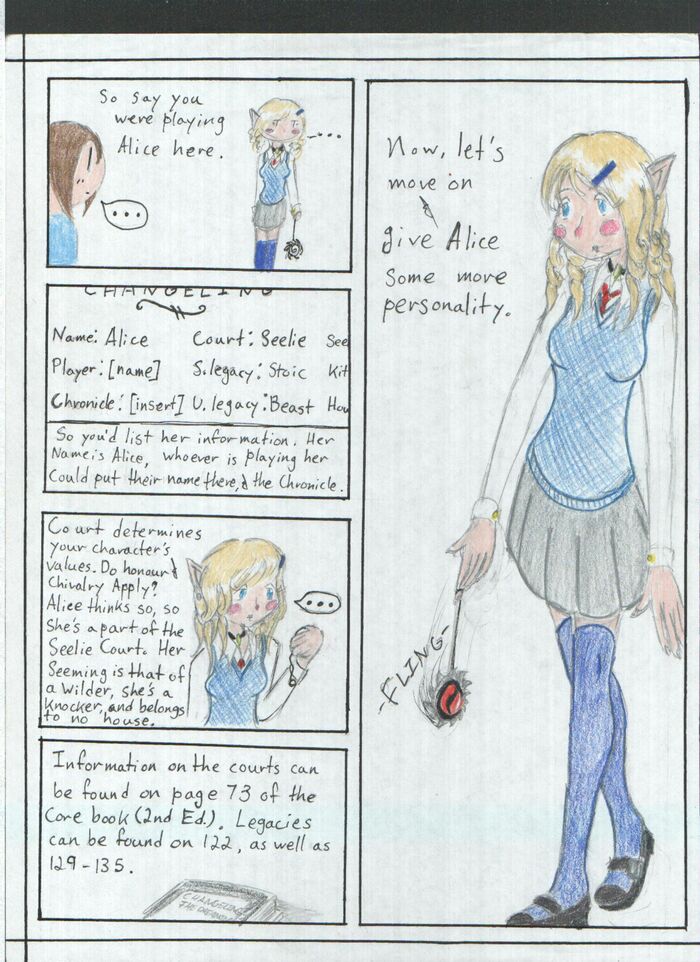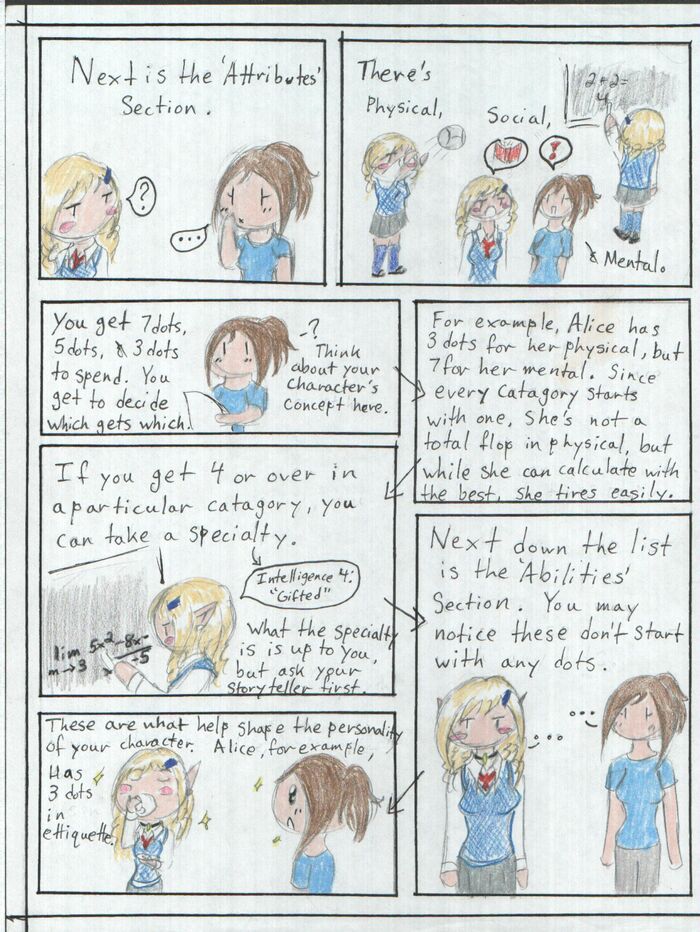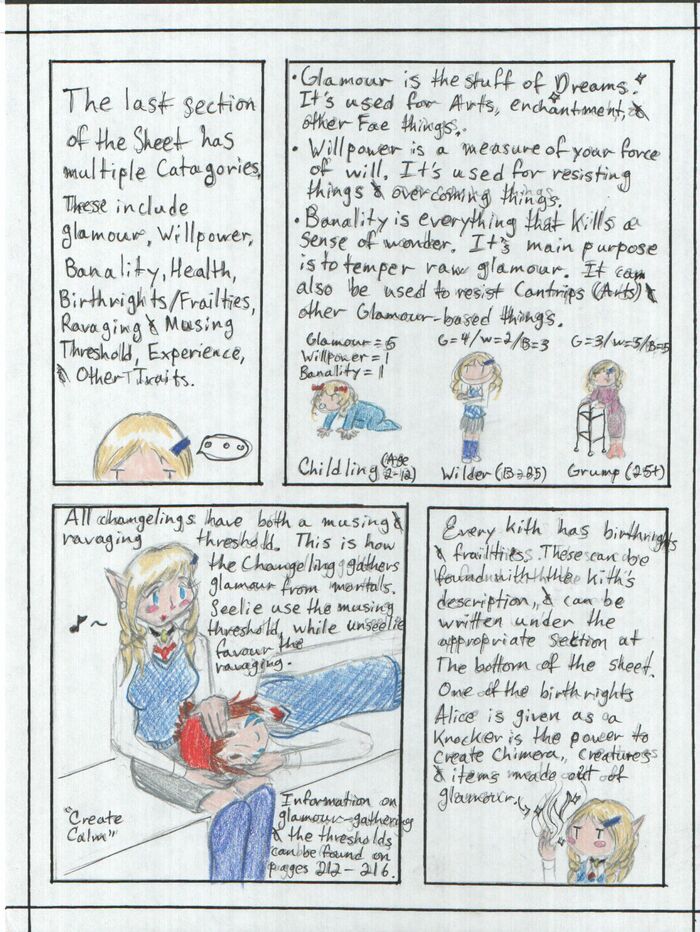This page is a resource on how to create a character for Changeling: The Dreaming. You will need a blank Character Sheet (check out the Sheet Bank here for one), a pencil (NOT a pen), a concept for your character (an idea of what you want them to be), and the Changeling: The Dreaming Second Edition Core Book (that is, unless you don't mind bouncing between the different pages here). The following comic pages will lay it out in pretty basic terms, but just in case, I'll elabourate on what was said after each page.
Read the page top to bottom, left to right. I'll break down the page by section to make things easier. The terms may seem confusing now, but they'll be gone into detail later, so don't worry too much. It's also worth noting that this tutorial is based off the basic 2-page Changeling sheet, not the 4-page sheet or one of the Kith-Specific sheets. (The latter doesn't have the "Kith" section as stated in the comic. For a full list of Kiths, see The Kith List. Remember, though, that most of the Kiths on that list don't have sheets specific to them.)
Apologies about how wordy this comic is, and for any crappy handwriting. Alice is going to be our example character here, so I hope you like her. And before anyone asks, no, I'm not going to make her character sheet public.
Just in case you don't have the book, you can also refer to the Seelie Court and Unseelie Court pages here for info on those. Remember that the court tenets (basically, the virtues that make up the backbone of what it is to be (Un)Seelie) are not always black and white; many different Kiths and Houses have their own interpretations of what it is to be part of that court.
All right, now we're getting to the interesting part. Having a character concept will REALLY help you here, since you now get to determine how your character's strengths and weaknesses are laid out. You will have 7 dots, 5 dots, and 3 dots to spend in the Physical, Social, and Mental categories (you get to decide which gets which value, which is why the concept will prove so handy). If you get 4 or more dots in a particular trait, you have the option of taking a Specialty (for example, you could have Cat-Like Reflexes for a Dexterity Specialty or Sex Appeal for an Appearance Specialty). Not all Storytellers like Specialties, though, so before doing that, make sure to talk to your Storyteller about it.
The Abilities section starts off with no dots, and you have 13, 9, and 5 dots to spend per category (it doesn't have to match the 7/5/3 you did on the Abilities section, just so you know). Do yourself a favour and DON'T spread the points out evenly, as tempting as it may be. It typically results in a bland character and though you end up with points in damn near everything, you usually don't have enough in anything for it to be particularly useful.
The third section of the sheet is the Advantages section. You get 5 points to spend in Backgrounds, 3 in Arts and 5 in Realms (DON'T MIX THEM UP!!!). Sure, this doesn't seem like much to spend in Arts, but there are ways around that if you want a particularly *magical* character. However, if you aren't attempting to create some kind of wizard, one or two Arts will suit you just fine. (A full list of Arts can be found on the Arts page, but bear in mind that some may not be compatible with certain Kiths. Be sure to consult your Storyteller on which Arts are appropriate for your character and campaign.)
The bottom section is reserved for all the extra bits that didn't fit elsewhere. Glamour, Willpower, and Banality are best to fill in first, and refer to the comic page for the numbers. (If you so desire, you can buy extra Willpower and Glamour later, but not extra Banality. For more information on what Glamour and Banality are and what they're used for, see Part III of this series, Glamour and Banality Explained.
Though it RARELY comes up in my games, it's good to have a Ravaging or Musing Threshold just in case the topic DOES come up. Threshold (Musing for Seelie and Ravaging for Unseelie) indicates how your character goes about getting Glamour. Refer to pages 212-216 of the Core Book for more information about the Thresholds.
Regardless of Kith, everyone has Birthrights and Frailties. These will be automatically listed on the Kith-Specific sheets, but in case you don't have one of those or are playing an expanded character, you can refer either to the books or to the Kith's page on here and write them in.
I have never awarded experience in my games, but that's mostly due to the game breaking up before it could even be discussed. Either way, some Storytellers find it constructive to award experience based on various factors (most creative roleplaying, completing a goal or perhaps overcoming a character's personal obstacle) that can then be used towards improving your character's stats. There's a space to mark down experience at the bottom, and talk to your Storyteller about how to use it.
The "Other Traits" section at the bottom is best used for Merits and Flaws, but can also be used to mark down important gear, Treasures or Secondary Abilities if you have them. If you run out of room, don't be afraid to use the back of the sheet. Merits and Flaws are special traits that can either take away (Merits) or grant (Flaws) Freebie Points by taking them on. Freebie Points are explained in the next paragraph.
Remember how I said earlier that there were ways around only having 3 points for Arts? Freebie Points is one of them. To be spent at the end of character creation, Freebie Points are basically the sprinkles on the ice cream of your character. You get 15 points to start with, and the breakdown for Freebies is as follows:
| Trait | Points per Dot | |
|---|---|---|
| Arts | 5 | |
| Attributes | 5 | |
| Glamour | 3 | |
| Realms | 3 | |
| Willpower | 2 | |
| Abilities | 2 | |
| Backgrounds | 1 |
Please remember that this page was intended mostly to be a clarification and/or quick-start guide. You really should consult your Storyteller completely during character creation, and read the book. It may seem like a difficult task, but you'll be all the better prepared for it. And always keep in mind that this is a Story-Based Game; the more detail you give your character, the richer s/he and the story become. With that, I hope this helped, and I'll see you in Part II - Gameplay Basics!
-K.






